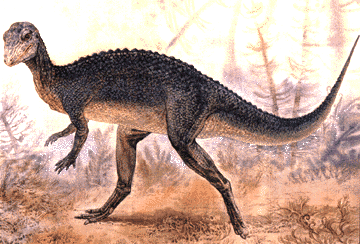
Arstanosaurus
ia. skeleton
Archosauria: Ornithischia: Ornithopoda: Hadrosauridae
Locality:
Gobi Desert, southern Mongolia
Age: Late Cretaceous
(Santonian), 85 million years ago
Meaning of name: "reptile from Arstan well"
The
iguanodonts gave rise to the hadrosaurids, or duck-billed
dinosaurs; the most
evolutionary advanced group of ornithopods. They are widely
distributed in the northern
hemisphere in the Late Cretaceous and only one species
is known from South America.
The hadrosaurids are distinguished first of all by
their extremely high specialized dental
apparatus. Their lateral teeth possessed
up to five replacement teeth per each tooth with
up to three of them being functional
simultaneously. These dental batteries allowed the
hadrosaurs to become the most
effective terrestrial herbivores of their time.
In many hadrosaurs the skull roof
formed crests of diverse shapes
and sizes with hollows or nasal cavities inside.
This
skeleton is that of a young hadrosaurid or duck-billed dinosaur,
possibly aged
3-4 years, although Jack Horner of the Museum of the Rockies
contends that this
specimen is probably not more than one-year-old.
Further he contends that this
is not a hadrosaurid but rather an intermediate genus.
He has been invited to
resolve this issue by closer inspection
of this skeleton when the exposition ends.
Adults
were probably 6-7 meters high and up to 15 meters long. Studies of the
microstructure
of the bones suggest that the young grew rapidly.
They quite likely attained a
height of 40-50 centimeters in the first year after hatching.
This skeleton is
reputed to be the finest,
most complete small dinosaur skeleton in the world.





